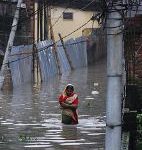March 28, 2008, saw the launch of China’s Ministry of Environmental Protection (MEP). As stated in its mission, this new cabinet-level ministry will take responsibility for China’s environmental governance. MEP is tasked to develop and organise the implementation of environmental protection; to manage all related planning, policy and standards; and to coordinate across jurisdictions and levels of government to solve the country’s major environmental problems.
The creation of the MEP is an example of the widespread reforms that have been transforming China’s government in the past decades. Since 1982, five waves of major reforms have reduced the number of government ministries from 52 to 27. The latest round of these has aimed to create a “small government in a big society” , as public-sector priorities have shifted from economic development to regulation and public service. However, such a bold long-term transformation will only be possible by maintaining current rates of economic growth while simultaneously reducing inflation pressure and preserving central government macroeconomic performance. The Chinese government will also need to strike the dedicate balance between development, environment and social stability.
![]()
After more than 30 years of rapid economic growth and development, China is facing unprecedented challenges in its efforts to protect its environment and natural resource base. The rapid deterioration of the nation’s environmental quality and depletion of its natural resources are threatening the lives and health of the largest population in the world and the very potential for sustained growth of the economy. Some of the most pressing challenges include:
Air Quality. Two of the Blacksmith Institute’s 10 most polluted cities are in China. Three major city clusters in China–Beijing-Tianjin-Tangshan, the Yangtze River Delta and Pearl River Delta–all face significant air pollution problems. Zhong Nanshan, head of the Guangzhou Institute of Respiratory Diseases, warned that most people older than 50 experience “black lung” as result of air pollution in Guangzhou city. With the 2008 Olympic Games right around the corner, Chinese officials in Beijing have introduced an even-odd license plate number system to control the number of vehicles on city roads after July 20 in an effort to improve air quality for the athletes and visitors.
Water Pollution. Huge blooms of blue-green algae have led to severe water pollution at Taihu Lake in the Yangtze Delta both this summer and last. According to the 2006 China Environmental Condition Communique, 28 percent of the nation’s 745 water-quality monitoring sections are under standard V, which is the lowest level of China’s Environmental Quality Standards for Surface Water. For more than ten years, the central government has poured money into pollution treatment projects on the Huai River and Dianchi Lake, with little success. Only 43.2 percent of the 46 sections of the river’s 44 major tributaries passed quality tests, according to a 2007 report by the Huai River Committee.
Climate Change. The results of China’s Assessment Report on Climate Change show that annual average air temperature has increased by 0.5-0.8°C over the last century (slightly higher than the average global temperature rise), with most of the temperature rise observed in the last 50 years. Along China’s coasts, sea levels have risen an average of 2.5 mm annually over the last 50 years. China’s mountain glaciers have also retreated, and the trend is accelerating. The geography and climatic conditions of the country already give rise to frequent extreme events. Recently, though, extreme events have been exacerbated by the complexity and fragility of China’s ecosystems, and by the fact that its three largest urban agglomerations and industrial centres are in coastal areas. In rural areas, agricultural output could be reduced by between 5 and 10 percent by 2030. The Fourth Assessment Report of the Intergovernmental Panel on Climate Change (IPCC) warned that China will be one of the world’s most affected regions if the climate continues to change as predicted.
Pan Yue, Vice Minister of Environmental Protection, estimates that two environmental incidents occur every three days in average around China, threatening the government’s goal of creating a “Harmonious Society”. In 2005, the formal public hearing held in the wake of the controversy surrounding the Yuan Ming Yuan Park, which used impermeable membranes on the bottom of the Park’s lakes to save water, but impacted both the area’s ecosystems and nearby historic cultural sites, was the first of its kind in the environmental arena. The project was stopped after this hearing.
Since then, Chinese people have become more engaged in the environmental movement. Increasing environmental awareness and concern for environmental justice have led to widespread environmental protests. In June 2007, the citizens of Xiamen, a city on the southeastern coast known for its environmental awareness and ecotourism industry, demonstrated against the construction of a chemical factory slated to be built nearby. People in Shanghai protested against an extension of the city’s Maglev system in January 2008, and in May citizens in Chengdu demonstrated against the construction of a petrochemical factory and oil refinery. With the release of The Regulations on Government Disclosure of Information in May 2008, calls for information transparency and public participation will continue to increase.
With increasing calls for action to ensure environmental quality, the government has responded with mixed results. For example, billions of dollars have been spent to clean up pollution on the Huai River, one of China’s major rivers, but this effort has resulted in little real progress. The issue here is decentralisation: the local environmental governor is nominated and assigned by the local officer, and all local environmental improvement projects are funded solely by the local government. While the central government may have a strong will when it comes to the environment, local reluctance is still a big problem. Local governments lack both the incentives and the capacity to implement well-developed projects. High-level Chinese leaders often promise “clean water and clean air for everybody,” but this simple-sounding goal is, in reality, not an easy job.
Elevation of the MEP to the cabinet level is a promising step, but this does not guarantee results. Although its status improved over the last 30 years, the environmental administration is still comparatively weak in the cabinet. The Environmental Protection Storm, initiated by MEP Vice Minister Pan Yue, is both a national campaign to promote environmental awareness and an example of how the MEP has had to use relatively creative methods to consolidate its power in the government. Notable setbacks, such as the MEP’s failure to implement a new “green GDP” evaluation system given the complexity of greening the GDP, show that the ministry is not yet as efficient and effective as other core ministries like the National Development and Reform Commission (NDRC), China’s macroeconomic management agency.
To better understand the Chinese system of environmental management, it is helpful to compare it to analogous systems in the United States and European Union.
Structure. Learning from experiences in the United States, China established five regional inspection offices in 2006 in an effort to foster regional coordination. But, in contrast to the U.S. system, the province is the basic political and economic unit in China. Environmental agencies at the provincial level are not staffed by the central government and are funded exclusively by local governments. This disconnect has effectively turned provincial “environmental protection officers” into professional workers with no real power. The five regional-level inspection offices will have little influence over the situation on the ground, as they still do not have the power to coordinate the provincial offices.
Personnel. In a country of 350 million people, the US Environmental Protection Agency has more than 17,000 employees, not including outside contractors. China, a country with four times the population and significantly more pollution per capita, has only about 300 workers at the MEP in Beijing and perhaps 30 people in each of the five regional inspection offices. Including affiliate agencies and institutes, the total number of personnel can perhaps reach 2,600. Some important support comes from the affiliated research institutions, but the ministry remains weak, lacking the decision-making capacity and financial resources of many other agencies.
Enforcement. China’s central regulations and rules do not have the same force as US or European laws. As one of its key instruments, China’s central government issues five-year plans that set general national targets, which in turn are delegated to local governments; promotions for government workers are based on how well they meet those goals. The current 11th Five-Year Plan contains two major environmental goals: a 20-percent improvement in energy efficiency and 10-percent decreases in major pollutants. But as long as China’s promotion system is solely based on GDP growth, any government mandates to curb pollution will remain secondary, and any environmental targets will not be fully enforced on the ground.
The way forward
Zhang Shiqiu, professor at Peking University’s College of Environmental Sciences and Engineering, delivered her worries at the first Chinese Environmental Protection System Reform Conference in 2007. She said that China is currently in its most critical time for the transition of environmental regulatory system, given the concern of China is facing the most serious period of environmental damages, which will likely continue into the near future. She highlighted emerging environmental incidents, particularly serious pollution accidents that increase environmental risks and threaten national environmental security. She also noted that the environmental crisis has recently instigated social conflicts and weakens social stability.
In her view, an effective environmental rights structure needs clear definitions and clarifications. She proposed that environmental management should turn from “sector management” to “public management” that integrate public resources governance and public participation into their management with people oriented pursuit. She also calls for the transition of environmental regulatory system from “local based” to “regional based,” “from single-pollutant control to multiple pollutants control strategy,” “from end-of-pipe to lifecycle management, which focuses on the restructuring of the economy and energy consumption,” and to use more market-based instruments (MBIs) to provide incentives to enterprises and social actors, especially a combination of damage compensation schemes, eco-services payment schemes and pollution/resources taxation schemes.
As a leading consulting group, the China Council for International Cooperation on Environment and Development (CCICED) has united with top leaders and international experts. At its 5th Annual General Meeting, the China Task Force on Environmental Governance released a report, recommending that China strengthen its environmental governance in four major issue areas:
- Improving the government’s capacity to enforce environmental laws and oversee the implementation of environmental programs, to enhance the government’s capacity to control environmental pollution, and to improve the management of natural resources;
- Engaging the business sector to take a more proactive role in environmental management by providing incentives to those that perform well and punishing those that do not, and by promoting best practices of industrial production and hazardous accident preparedness;
- Engaging civil society by providing greater transparency of information concerning environmental and natural resource conditions and of government decision-making activities, combined with access and participation by stakeholders, NGOs, and the general public, and;
- Establishing greater policy coherence and planning capacity for both domestic and international environmental and natural resource issues. Promote the capacity and incorporate this into the expectations of performance of other government ministries and agencies.
The World Bank has also undertaken projects to support environment management in China. The Bank believes that while MEP has seen many successes, the overall deterioration of the environment has not been reversed. To their mind, environmental management in China has become increasingly complex, as widespread socioeconomic changes have created new and urgent environmental challenges. Environmental management, which is largely dealt with by the Ministry of Environmental Protection, has been further complicated by ongoing institutional reorganisation and the sheer size of the country. Yet many of the country’s natural resources and environmental services are already under great pressure. China’s need for effective environmental management is becoming ever more important. In the end, though, “only a greatly expanded and strengthened coordination framework between local and central level institutions will be able to cope with this challenging agenda.”
He Gang completed his master’s degree at Peking University. He was a member of the youth delegation to the 2005 UN Climate Change Conference in Montreal
Homepage photo by tripper54



